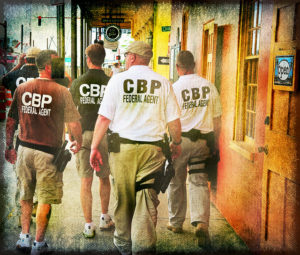The Federal Government Is Helping Police Nationwide Secretly Exploit Intrusive Technologies
Unfortunately, power loves the dark. Cali4beach / CC-BY-2.0
1
2
3
4
Cali4beach / CC-BY-2.0
1
2
3
4
In a no-less-bizarre incident, the Sarasota Police Department was about to turn some Stingray records over to the ACLU in accordance with Florida’s open-records law, when the U.S. Marshals Service swooped in and seized the records first, claiming ownership because it had deputized one local officer. And excessive efforts at secrecy are not unique to Florida, as those charged with enforcing the law commit themselves to Stingray secrecy in a way that makes them lawbreakers.
And it’s not just the public that’s being denied information about the devices and their uses; so are judges. Often, the police get a judge’s sign-off for surveillance without even bothering to mention that they will be using a Stingray. In fact, officers regularly avoid describing the technology to judges, claiming that they simply can’t violate those FBI nondisclosure agreements.
More often than not, police use Stingrays without bothering to get a warrant, instead seeking a court order on a more permissive legal standard. This is part of the charm of a new technology for the authorities: nothing is settled on how to use it. Appellate judges in Tallahassee, Florida, for instance, revealed that local police had used the tool more than 200 times without a warrant. In Sacramento, California, police admitted in court that they had, in more than 500 investigations, used Stingrays without telling judges or prosecutors. That was “an estimated guess,” since they had no way of knowing the exact number because they had conveniently deleted records of Stingray use after passing evidence discovered by the devices on to detectives.
Much of this blanket of secrecy, spreading nationwide, has indeed been orchestrated by the FBI, which has required local departments eager for the hottest new technology around to sign those nondisclosure agreements. One agreement, unearthed in Oklahoma, explicitly instructs the local police to find “additional and independent investigative means” to corroborate Stingray evidence. In short, they are to cover up the use of Stingrays by pretending their information was obtained some other way — the sort of dangerous constitutional runaround that is known euphemistically in law enforcement circles as a “parallel construction.” Now that information about the widespread use of this new technology is coming out — as in the Shemar Taylor trial in Baltimore — judges are beginning to rule that Stingray use does indeed require a warrant. They are also insisting that police must accurately inform judges when they intend to use a Stingray and disclose its privacy implications.
Garbage In, Garbage Out
And it’s not just the Stingray that’s taking local police forces into new and unknown realms of constitutionally questionable but deeply seductive technology. Consider the hot new trend of “predictive policing.” Its products couldn’t be high-techier. They go by a variety of names like PredPol (yep, short for predictive policing) and HunchLab (and there’s nothing wrong with a hunch, is there?). What they all promise, however, is the same thing: supposedly bias-free policing built on the latest in computer software and capable of leveraging big data in ways that — so their salesmen will tell you — can coolly determine where crime is most likely to occur next.
Such technology holds out the promise of allowing law enforcement agencies to deploy their resources to areas that need them most without that nasty element of human prejudice getting involved. “Predictive methods allow police to work more proactively with limited resources,” reports the RAND Corporation. But the new software offers something just as potentially alluring as efficient policing — exactly what the president’s task force called for. According to market leader PredPol, its technology “provides officers an opportunity to interact with residents, aiding in relationship building and strengthening community ties.”
How idyllic! In post-Ferguson America, that’s a winning sales pitch for decision-makers in blue. Not so surprisingly, then, PredPol is now used by nearly 60 law enforcement agencies in the United States, and investment capital just keeps pouring into the company. In 2013, SF Weekly reported that over 150 departments across the nation were already using predictive policing software, and those numbers can only have risen as the potential for cashing in on the craze has attracted tech heavy hitters like IBM, Microsoft, and Palantir, the co-creation of PayPal co-founder Peter Thiel.
Like the Stingray, the software for predictive policing is yet another spillover from the country’s distant wars. PredPol was, according to SF Weekly, initially designed for “tracking insurgents and forecasting casualties in Iraq,” and was financed by the Pentagon. One of the company’s advisors, Harsh Patel, used to work for In-Q-Tel, the CIA’s venture capital firm.
Civil libertarians and civil rights activists, however, are less than impressed with what’s being hailed as breakthrough police technology. We tend to view it instead as a set of potential new ways for the police to continue a long history of profiling and pre-convicting poor and minority youth. We also question whether the technology even performs as advertised. As we see it, the old saying “garbage in, garbage out” is likely to best describe how the new software will operate, or as the RAND Corporation puts it, “predictions are only as good as the underlying data used to make them.”
Your support matters…Independent journalism is under threat and overshadowed by heavily funded mainstream media.
You can help level the playing field. Become a member.
Your tax-deductible contribution keeps us digging beneath the headlines to give you thought-provoking, investigative reporting and analysis that unearths what's really happening- without compromise.
Give today to support our courageous, independent journalists.





You need to be a supporter to comment.
There are currently no responses to this article.
Be the first to respond.